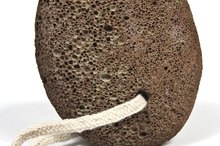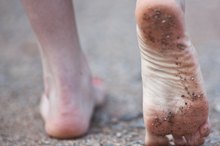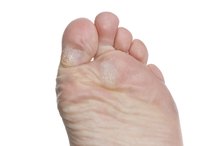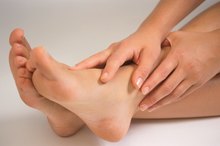When to See a Podiatrist for Cracked Heels
Smooth, healthy feet look and feel good. Cracked, dry skin on your feet, especially along your heels, is unattractive and can also be painful or itchy. Your feet can get so flaky and callused that wearing sandals is out of the question, keeping you uncomfortable in the summertime. Though it’s usually simple to treat dry or cracked heels at home, if the condition becomes severe enough, it warrants a visit to a podiatrist.
About Cracked Heels
Your feet can develop skin cracks anywhere, but the heels and edges of the toes crack most frequently. These small splits in the skin can be painful enough to make walking difficult. Cracks usually develop in very dry skin, or where calluses have formed a thick, hard crust. The normal motion and pressure of walking can be enough to split the toughened, inflexible skin along the callus.
- Your feet can develop skin cracks anywhere, but the heels and edges of the toes crack most frequently.
Causes
How to Fix Cracked Heels
Learn More
Calluses build up on areas of the foot that are irritated or rubbed by your shoes. You can also develop calluses by frequently walking barefoot on rough surfaces. Once you have callused heels, you're at risk for cracks. Long periods of standing, wearing open shoes and being overweight also contribute to heel cracks. Medical conditions such as diabetes, thyroid problems, eczema and psoriasis also increase the risk of painfully cracked heels. If you have a medical condition that affects your feet, you should consult a podiatrist or your regular doctor.
- Calluses build up on areas of the foot that are irritated or rubbed by your shoes.
- Long periods of standing, wearing open shoes and being overweight also contribute to heel cracks.
Home Treatment
Most cases of dry, cracked heels or toes respond quickly to home treatment 2. Before going to bed each night, slather a thick coating of foot cream over the entire surface of each foot. Pay special attention to your heels and the edges of your toes. Slip a pair of cotton socks over the lotion so it won't soak into your sheets instead of your skin. In the morning, while in the shower or bath, gently remove dead skin with a pumice stone or callus file. You should see improvement within a few days. If your cracks don't heal, or your feet get worse, it's time to visit the podiatrist.
- Most cases of dry, cracked heels or toes respond quickly to home treatment 2.
- In the morning, while in the shower or bath, gently remove dead skin with a pumice stone or callus file.
When to See the Podiatrist
Salicylic Acid & Heel Cracks
Learn More
You can usually treat your cracked heels at home, but some situations call for a podiatrist's care. Elderly people who develop severe cracks should seek medical attention to prevent ulcers or bedsores from forming. See your podiatrist or doctor if your heels crack and you are diabetic, have impaired circulation or an autoimmune disorder, or suffer from skin conditions. If you are in good health but home treatment does not heal the cracks or your feet bleed, make an appointment with a foot specialist.
- You can usually treat your cracked heels at home, but some situations call for a podiatrist's care.
- If you are in good health but home treatment does not heal the cracks or your feet bleed, make an appointment with a foot specialist.
Related Articles
References
- Foot & Ankle Center of Washington: Cracked Heels and Heel Fissures
- Family Foot and Ankle Centers: Treatment for Dry, Cracked Heels
- Institute For Preventive Foot Health. National Foot Health Assessment 2012. 2012.
- Boutrand LB, Thépot A, Muther C, et al. Repeated short climatic change affects the epidermal differentiation program and leads to matrix remodeling in a human organotypic skin model. Clin Cosmet Investig Dermatol. 2017;10:43-50. doi:10.2147/CCID.S120800
- Kapur S, Watson W, Carr S. Atopic dermatitis. Allergy Asthma Clin Immunol. 2018;14(Suppl 2):52. doi:10.1186/s13223-018-0281-6
- Safer JD. Thyroid hormone action on skin. Dermatoendocrinol. 2011;3(3):211-215. doi:10.4161/derm.3.3.17027
- Hashizume H. Skin aging and dry skin. J Dermatol. 2004;31(8):603-609. doi:10.1111/j.1346-8138.2004.tb00565.x
- Parker J, Scharfbillig R, Jones S. Moisturisers for the treatment of foot xerosis: a systematic review. J Foot Ankle Res. 2017;10:9. doi:10.1186/s13047-017-0190-9
- Linus Pauling Institute. (2012-2016). Oregon State University: Micronutrient Information Center: Essential Fatty Acids and Skin Health.
Writer Bio
Living in California, Michelle Ullman is a professional writer with particular expertise in home, garden and pet/nature topics. Her work is published on many websites. She loves crafts and has a deep interest in design and DIY projects.







